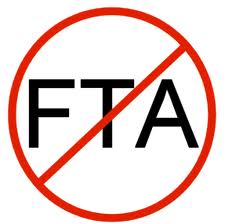
| In preparing for FTAs, Vietnam needs to install non-tariff barriers | |
Pham Chi Lan, a well known economist in Vietnam, has urged relevant ministries to consider installing non-tariff barriers to control the imports, which she believes a very important thing that needs to be done in preparing for the implementation of free trade agreements (FTAs). From now to 2015, under the commitments Vietnam has made in six bilateral and multilateral FTAs, Vietnam will have to gradually cut down the tariffs of thousands of goods items to 0-5 percent, mostly to 0 percent, and open the domestic market widely for imports. Lan said that the low import tariffs will pave the way for foreign made products to flow to Vietnam which later may dominate the domestic market. This should be seen as big worry for the national economy, where the technical barriers remain imperfect, the competitiveness of enterprises remains weak and institutional reform has not been completed. According to Lan, the trade liberalization levels committed in the FTAs between Vietnam and ASEAN, between ASEAN and Japan, ASEAN and China are much higher than the committed levels in joining WTO (the World Trade Organization). The tariff cuts are also sharper and the market openness is bigger in FTAs, with 90 percent of tax categories to be cut to zero percent by 2015, and the other 10 percent by 2018. This means that the goods from other countries, especially from China, in the agreement with which, the sharpest tax cuts will occur in 2011-2015, will flow to Vietnam. This also means the big challenge for the national economy and Vietnamese enterprises. Lan said that she now still cannot imagine what the national economy structure will be like by 2015 or 2020 in such a context. Besides the big challenges you have mentioned, FTA will also bring big opportunities to Vietnamese enterprises, as they can boost exports to the countries which have FTAs with Vietnam. What do you think about the capability of Vietnamese enterprises to take full advantage of the FTAs to expand production and export? The statistics released by the Ministry of Industry and Trade at a recent workshop show that about 30 percent of enterprises can take full advantage of the tax cuts in FTAs to increase exports. I think that the 30 percent of enterprises could be foreign invested enterprises. It is not a surprise at all, and this occurs in other ASEAN countries as well. Foreign invested enterprises always prove to be the ones which can be the best in taking full advantage of their opportunities. They are Japanese and South Korean invested enterprises. Meanwhile, I think that domestic enterprises still cannot exploit the opportunities brought by FTAs. You can see that the highest growth rates in export still can be seen in familiar markets, including the US, EU and Japan, while Vietnam still imports big volumes of products from ASEAN, and especially from China. So what should Vietnam do to prevent the challenges from becoming the obstacles for Vietnamese enterprises? First of all, the State should install non-tariff barriers. Only the State has the right to set up standards as the tools to control imports. Regarding the technical barriers, experts have many times repeated that it is necessary to install technical barriers. Once the tariff is cut and the licensing procedures become simplified, it would be foolish if we do not think of setting up technical barriers. However, as far as I know, at that moment, the Ministry of Science and Technology said that if setting up overly high barriers, domestic enterprises would not be able to overcome the barriers. Meanwhile, if the barriers are low, this will pave the way for foreign made products to flow to Vietnam. I do not think this way. We can calculate the barriers every day. It is also necessary to set up high standards, and domestic enterprises should understand that they need to meet the high requirements to survive. I have to say that we still do not have good technical barriers to control the imports. This should be blamed on the relevant ministries Second, manufacturers should improve their production capability in order to compete successfully with imports, especially the ones from China. We should ask ourselves if we want to live or die. If we want to “surrender”, we should do this right now. If we want to survive, we need to change, and do this immediately. | |
| TBKTSG |
